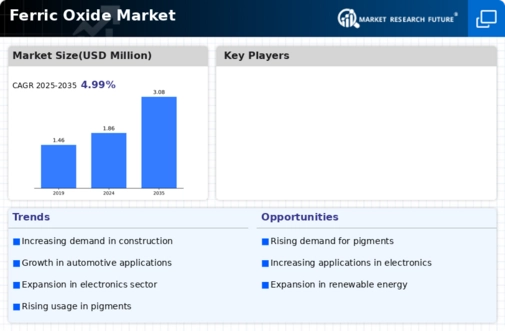Top Industry Leaders in the Ferric Oxide Market

The future of the ferric oxide market is expected to be shaped by several key trends, including the growing demand for sustainable solutions, the increasing adoption of nanotechnology, and the emergence of new applications in areas such as energy storage and environmental remediation.
Ferric oxide, also known as iron(III) oxide or Fe2O3, is a ubiquitous and versatile material used across diverse industries. Its diverse applications, ranging from pigments and coatings to catalysts and pharmaceuticals, fuel. This growth is driven by increasing demand from construction, paints and coatings, plastics, and electronics industries.
Strategies Adopted:
Product Differentiation: Key players are focusing on developing innovative products with superior properties to cater to specific end-use applications. This includes high-purity, nano-sized iron oxides, and pigments with enhanced color performance and durability.
Geographical Expansion: Established players are actively expanding their operations in emerging markets like Asia-Pacific and Latin America, where demand for ferric oxide is rapidly increasing. This expansion involves setting up new production facilities, acquiring local companies, and forging strategic partnerships.
Cost Optimization: Companies are implementing measures to improve operational efficiency and reduce production costs to maintain their competitive edge. This includes automation, process optimization, and resource-efficient technologies.
Sustainability: Growing environmental concerns are driving the demand for sustainable production practices. Key players are investing in technologies to reduce their environmental footprint, such as utilizing renewable energy sources and implementing waste reduction strategies.
Factors for Market Share Analysis:
Production Capacity: The ability of a company to meet the increasing demand for ferric oxide plays a crucial role in determining its market share.
Product Portfolio: A diverse and innovative product portfolio catering to various end-use applications helps companies gain a competitive advantage.
Geographical Reach: Companies with a strong presence in key markets, particularly emerging regions, are poised to capture a larger market share.
Brand Recognition: Established brands with a strong reputation for quality and reliability enjoy a competitive advantage in the market.
Financial Strength: Financial stability and resources enable companies to invest in R&D, expansion, and strategic acquisitions to grow their market share.
Competitive landscape
Major key players in the ferric oxide market are as follows: Karara Mining Ltd (Australia), Western Australia Iron Ore (BHP) (Australia), Labrador Iron Mines (Canada), Carajás Mine (Vale) (Brazil), Cleveland-Cliffs Inc (US), SIMEC (Australia, Fortescue Metals Group Ltd (Australia), Applied Minerals Inc (US), Shree Minerals Ltd (Australia) and Atlas Iron Pty Ltd (Australia)
Recent Development
June 2023:
Lanxess AG: Reported the extension of its engineered iron oxide shades creation limit in Krefeld-Uerdingen, Germany, by 20%. The development is supposed to be finished by mid-2024.
BASF SE: Sent off another scope of superior execution iron oxide colors under the Irgaphor® brand, explicitly intended for elite execution plastics applications.
July 2023:
Tronox Restricted: Reported the obtaining of the TiZir Restricted mineral sands business, reinforcing its situation in the titanium feedstock and shade markets. This obtaining additionally gives them admittance to zircon, which can be utilized in the creation of ferric oxide.

